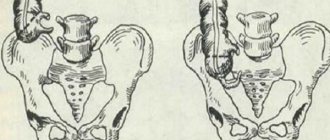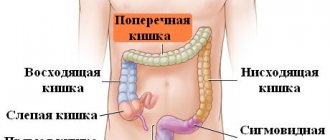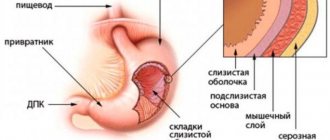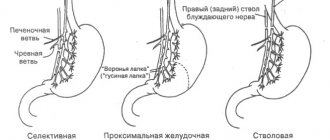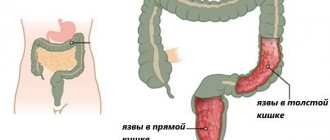When is a colostomy indicated?
It is quite obvious that creating a fistula of the colon for the unnatural discharge of feces is a very extreme measure, and it is carried out for health reasons. The colostomy may be temporary or permanent (permanent stoma).
Recently, sphincter-preserving operations have been intensively developed and implemented. But despite this, about 25% of operations on the large intestine result in an ostomy.
In what cases might this situation arise:
- Inoperable tumor. If it is impossible to perform radical surgery (for example, the tumor has grown into neighboring organs or the patient is very weakened, with distant metastases), colostomy is performed as a palliative operation.
- After radical removal of anorectal cancer. If the tumor is located in the ampullary and middle sections, the rectum is extirpated along with its sphincter, and natural bowel movement becomes impossible.
- Anorectal fecal incontinence.
- Congenital anomalies of the intestinal outlet.
- Failure of a previously performed anastomosis.
- Intestinal obstruction. In this case, a colostomy is applied at the end of the first stage of the operation after removing the obstacle. After some time it is removed.
- Intestinal injury.
- Enterovaginal or enterovesical fistulas during their treatment.
- Severe ulcerative colitis or diverticulitis with bleeding and intestinal perforation.
- Perineal wounds.
- Post-radiation proctosigmoiditis.
COLOSTOMY
COLOSTOMY
(Latin colon colon + Greek, stoma mouth, opening, passage) - the operation of forming an external specially applied fistula of the large intestine - colostomy. Depending on the part of the large intestine on which the fistula is placed, one should distinguish between cecostoma, ascendostomy, transversostoma, descendostomy and sigmostoma. Colostomies can be end (single-barrel), parietal and double-barrel, temporary and permanent. In the domestic literature, colostomies are usually called intestinal fistulas or (when the fistula is applied to the left parts of the colon) artificial anus.
Indications:
pronounced disturbances in the patency of the large intestine of an organic nature, which cannot be eliminated by one-stage resection with anastomosis; creating intestinal decompression under unfavorable conditions for healing of the anastomosis; unremovable tumor and rectal trauma.
The operation is preferably performed under anesthesia. Access - median laparotomy (see). K. is performed after revision of the abdominal cavity. The intestine is removed through a special wound in the lateral sections of the abdomen, 3-4 cm away from the edge of the ilium, in order to facilitate the care of the colostomy. When applying parietal and double-barrel colostomies, the edges of the peritoneal incision are sutured to the edges of the skin wound, and then the wall of the removed intestine is fixed around the circumference with the same sutures. With a double-barreled colostomy (transverso- and sigmostoma), the intestine is mobilized so that it is freely removed above the skin level, and a “spur” is placed under it. In this type of operation, the intestinal lumen is usually not opened immediately, but after 1-2 days.
End (single-barrel) colostomies are applied in two fundamentally different ways. With a colostomy, the end of the intestine is removed in the form of a column, protruding significantly above the skin level. The formation of a colostomy proceeds slowly, with pronounced processes of granulation, scarring and gradual epithelization. Such a colostomy narrows and becomes deformed, which can lead to intestinal obstruction.
With a “flat” colostomy (at the skin level), the walls of the removed intestine are sutured directly to the edge of the skin wound. Such a colostomy does not subsequently narrow and functions well. This technique involves separate suturing of the peritoneum around the circumference of the intestine in the abdominal cavity without suturing the peritoneum to the skin. Many surgeons successfully conduct the intestine to the skin wound through a canal under the detached peritoneum (retroperitoneal intestinal passage). This method prevents complications of colostomy such as pericolostomy abscesses, immersion of the colostomy into the abdominal cavity, necrosis of the excreted intestine, etc.
Exodus
The operation depends on the nature and course of the underlying disease for which the colostomy was performed.
See also Anus praeternaturalis, Intestines, operations.
Bibliography:
Boguslavsky L. S. Technique of colostomy at the skin level, Surgery, JVb 5, p. 80, 1972; Melnikov R. A., Bernshtein M. I. and Simonov N. N. Our experience in treating cancer patients over 70 years old, Vestn, hir., t. 111, no. 8, p. 16, 1973; Ryzhikh A. N. Atlas of operations on the rectum and colon, p. 76, M., 1968; Modern stoma care, ed. by F. S. Walker, Edinburgh - L., 1976.
V. D. Fedorov.
Types of colostomy
As already mentioned, a stoma can be
- Temporal.
- Constant.
By localization:
- Ascending stoma (ascendostomy).
- Transverse stoma (transverse stoma).
- Descending stoma (descendostomy).
- Sigmostoma.
By shape
- Double-barreled (loop) – mostly temporary.
- Single-barrel (or end) - often permanent.
Preparing for surgery
Colostomy is almost always the final part of another operation (elimination of intestinal obstruction, colon resection, hemicolectomy, amputation and extirpation of the rectum). Therefore, preparation for surgery is standard for all intestinal operations. In case of planned intervention this is:
- Colonoscopy.
- Irrigoscopy.
- Blood and urine tests.
- Biochemical blood parameters.
- Coagulogram.
- Electrocardiogram.
- Fluorography.
- Markers of infectious diseases.
- Examination by a therapist.
- Colon cleansing using cleansing enemas or osmotic intestinal lavage.
In cases of serious condition of the patient (anemia, exhaustion), preoperative preparation is carried out whenever possible - transfusion of blood, plasma, protein hydrolysates, replenishment of fluid and electrolyte losses.
Quite often, a colostomy is the outcome of emergency operations for developed intestinal obstruction. In these cases, preparation is minimal and the obstruction must be cleared as soon as possible. If the patient’s condition is very severe, surgeons at the first stage minimize intervention: they impose a colostomy above the obstruction site, and the main intervention aimed at eliminating the cause of obstruction is postponed until the patient’s condition has stabilized.
Formation of a temporary colostomy
Usually, as a temporary measure, a double-barreled colostomy is formed (two ends of the intestine are brought to the abdominal wall - afferent and efferent).
temporary double-barreled colostomy
It is most convenient to form a colostomy from the transverse or sigmoid colon, which have a long mesentery; they are quite easy to remove into the wound.
The colostomy incision is made separately from the main laparotomy incision.
The skin and subcutaneous layer is excised using a circular incision. The aponeurosis is dissected crosswise. The muscles are separated. The parietal peritoneum is incised, its edges are sutured to the aponeurosis. This creates a tunnel for the removal of the intestine.
A hole is made in the mesentery of the mobilized intestine, and a rubber tube is inserted into it. By pulling the ends of the tube, the surgeon removes a loop of intestine into the wound.
A plastic or glass rod is inserted in place of the tube. The ends of the stick are placed on the edges of the wound, the loop of intestine seems to hang on it. The intestinal loop is sutured to the parietal peritoneum.
After 2-3 days, when the parietal and visceral peritoneum have fused, an incision is made into the withdrawn loop (pierced, then incised with an electric knife). The length of the incision is usually 5 cm. The posterior uncut wall of the intestine forms the so-called “spur” - a septum separating the proximal and distal knee of the stoma.
With a properly formed double-barreled colostomy, all fecal matter is removed through the adductor end to the outside. Mucus may be released through the distal (outflow) end of the intestine, and medications can be administered through it.
Carrying out the operation
A procedure aimed at removing part of the intestine outside is prescribed only in exceptional cases. Most often, specialists look for other ways to solve the problem. Before surgery, the surgeon determines the location of the stoma.
In accordance with the purpose of the artificial hole and the purpose, the operation can be carried out using several methods.
Overlay
The procedure is performed only using general anesthesia. The specialist first marks the location of the incision. It is noted first in a supine position and then corrected in a standing position.
The surgeon makes an incision on the skin in a circular motion, cutting through the epidermis and subcutaneous layer. Expands muscle tissue.
A section of the intestine is pulled outward in the shape of a loop. An incision is made on the wall of the organ, and its edges are sutured with the muscles of the abdominal cavity and connected to the skin.
Closing
In order to close the artificial exit, another surgical intervention is performed. This procedure is called a colostomy.
On this topic
- Oncogastroenterology
What kind of pain occurs with rectal cancer?
- Olga Vladimirovna Khazova
- December 3, 2021
The operation can be performed no earlier than two months after the first procedure, but no later than 6 months.
Before prescribing a colostomy, the specialist also takes into account the condition of the lower intestine. It is important that the entire output system functions without interruption.
The sigmoid colon colostomy is closed by releasing the sutures, after which the intestinal wall is sutured and repositioned into the abdominal cavity. The specialist applies stitches.
The main complication after the procedure to close the artificial opening is intestinal obstruction.
Reconstruction
If you have a temporary colostomy, in some cases surgery may be required to change the opening.
The procedure is prescribed if there are certain indications.
Closing a temporary colostomy
The closure of a temporary colostomy is carried out in a time frame individual for each patient. This could be several weeks or several months. It depends on the diagnosis, prognosis, and the condition of the patient himself.
Closing a colostomy is a separate operation. It can be done in several ways:
- The loop of intestine is sharply separated from the skin and other layers of the abdominal wall. The edges of the bowel defect are refreshed and the defect is sutured. A loop of intestine is immersed into the abdominal cavity. The peritoneum and abdominal wall are sutured in layers.
- The ostomized portion of the intestine is separated from the skin. Intestinal clamps are applied to both ends of the loop. A section of intestine with an exposed loop is resected and an end-to-end or end-to-side anastomosis is performed.
How is a colostomy performed?
The operation is performed under general anesthesia in a hospital setting. The formation of an artificial fecal fistula can be performed either open or laparoscopically. After preliminary marking of the future stoma, the surgeon dissects all layers of the anterior abdominal wall layer by layer until the entrance to the abdominal cavity.
Depending on the specific case, the end of the intestine or a loop of intestine is removed into the wound. According to this, colostomy can be single- or double-barreled. The intestine is fixed to the skin and a colostomy bag is put on.
Our operating rooms are equipped with modern equipment and surgical instruments necessary to perform a colostomy. The majority of operations are performed using laparoscopy. For each patient, an individual plan for surgery and recovery and rehabilitation measures is developed, based on the characteristics of the clinical case.
You have questions? We will be happy to answer any questions Coordinator Tatyana
Permanent colostomy
The most common reason for a permanent colostomy is cancer of the lower and middle ampullary rectum. With such a localization of the tumor, it is almost impossible to perform surgery while preserving the anal sphincter. In this case, treatment according to oncological criteria is considered radical: the tumor itself and regional lymph nodes are removed as widely as possible. If there are no distant metastases, the patient is considered cured, but...he will have to live without a rectum.
Therefore, the quality of the patient’s life directly depends on the quality of the formed colostomy.
The location of the colostomy is planned in advance before the operation. This is usually the middle of the segment connecting the navel and the left iliac crest. The skin in this area should be smooth, without scars or deformations, as they can interfere with the tight fit of the colostomy bags. The mark is made in a lying position, then adjusted in a standing position (patients with a pronounced subcutaneous fat layer may have skin folds).
A permanent stoma is usually single-barrel, that is, only one end of the intestine (proximal) is brought to the abdominal wall to drain feces.
At the final stage of the operation (rectal resection, Hartmann's operation), an incision is made in the skin, subcutaneous tissue and rectus abdominis muscle at the marking site. The parietal peritoneum is dissected, along the edges of the wound it is sutured to the aponeurosis and muscles.
A loop of intestine is brought out into the wound and intersected. The abductor end is sutured tightly and plunged into the abdominal cavity. The proximal end is brought out into the wound.
It is possible to form two types of colostomies:
- Flat - the intestine is sutured to the aponeurosis and parietal peritoneum, almost does not protrude above the surface of the skin.
- Protruding - the edges of the intestine are brought out into the wound by 2-3 cm, pulled together in the form of a “rose” and sutured to the peritoneum, aponeurosis and skin.
It is important that the incision of the skin and aponeurosis is not too small, the intestine should be brought out without tension or twisting, and the end of the intestine brought out must have a good blood supply. If all these conditions are met, the risk of complications and dysfunction of the colostomy in the future is minimized.
Intestinal stomas: types
Intestinal stomas - what are they, what types exist? This type of opening is also called an “artificial intestine.” They are installed in case of disturbances in the functioning of the corresponding organ after various surgical operations. For example, when removing the intestine or part of it. In this case, a permanent stoma is placed. And, for example, after an operation to remove a hernia, which has led to the body’s inability to cope with the elimination of feces naturally, surgeons perform a temporary ostomy.
Extraction to the abdominal wall of the colon is called a colostomy. And thin - ileostomy. From the outside, both types represent a section of intestine brought to the anterior wall of the abdominal cavity. Such a stoma is a fistula in the form of a rose, onto which a colostomy bag is installed externally.
In order to prevent postoperative complications and the spread of unpleasant odor, the intestinal stoma needs regular care.
After surgery, how to live with a colostomy
After the stoma is placed, it takes some time for the intestine to heal. Therefore, the patient receives only parenteral nutrition for several days. You are allowed to drink liquid every other day.
On the 3rd day after surgery, you are allowed to take liquid and semi-liquid foods.
After the colostomy operation, the patient remains in the hospital for 10 to 14 days. During this time, he will be taught how to care for his colostomy and use colostomy bags.
The psychological preparation of the patient before surgery is very important. The news that he will have to live with an unnatural anus is taken very hard. Due to insufficient information and insufficient psychological support, some patients refuse such an operation, dooming themselves to death.
You can live with a colostomy for a long time. Modern colostomy bags and stoma care products allow you to lead a normal, full life.
How to care for intestinal stomas?
With intestinal stomas, more often than with other types, complications associated with improper care are observed. Contrary to popular belief, colostomy bags should be changed only when necessary, since frequent changes lead to irritation and damage to the stoma and the area around the hole. Depending on the type of colostomy bag, it should be changed with the following regularity:
- when the contents of the one-component system have reached half or the patient has discomfort from the receiver bag;
- with a two-component system, the adhesive strip is left for 3 days.
The bag for receiving feces is put on directly at the time of defecation. After which they are immediately removed, the intestinal stoma is cleaned with a soap solution, and blotted dry with napkins. Then they are lubricated with the drug “Stomagesiv”, and the intestinal mucosa is lubricated with Vaseline to prevent cracks. A napkin folded in several layers is applied, the bandage is fixed with a plaster, and then the underwear is put on. Ostomy care is an important component of a patient's recovery.
Possible complications after ostomy
- Intestinal necrosis. It develops when its blood supply is disrupted, if the intestine is poorly mobilized during surgery and the mesentery is too stretched, a blood vessel is stitched, or it is pinched in an insufficiently wide incision of the aponeurosis. With necrosis, the intestine turns blue, then turns black. Necrosis is eliminated by repeated surgery.
- Paracolostomy abscesses. Occurs when an infection occurs. The skin around the stoma becomes red and swollen, pain intensifies, and body temperature rises.
- Retraction (retraction) of the stoma. It can also occur if the surgical technique is violated (too much tension). Requires surgical reconstruction.
- Evagination (prolapse) of the intestine.
- Colostomy stricture. It can develop gradually as a result of scarring of the tissues surrounding the stoma. Narrowing of the outlet may be complicated by intestinal obstruction.
- Irritation, weeping of the skin around the stoma, the addition of a fungal infection.
How to properly care for a gastrostomy tube?
Gastric stoma - what is it, in what cases is it established? When a gastrostomy is applied, a rubber tube is brought out, intended directly for transporting food into the stomach. During feeding, insert a funnel for convenience, and in between meals, clamp the tube with a thread or clothespin.
With a gastrostomy, the main goal of care is to treat the skin around the hole in order to prevent skin inflammation, diaper rash, and rash. The area of skin around the stoma is treated first with furatsilin solution using cotton balls and tweezers, and then with alcohol. After which it is lubricated with aseptic ointment. The procedure is completed by applying a bandage.
Ostomy care
It will take some time to adapt to a stoma (from several months to a year).
The intestinal wall exposed to the skin will be swollen for some time after the operation. It will gradually decrease in size (stabilize in a few weeks). The mucous membrane of the excreted intestine is red.
Touching the stoma during care does not cause pain or discomfort, since the mucous membrane has almost no sensitive innervation.
The first time after surgery, feces will be released continuously. Gradually, you can achieve their release several times a day.
The lower the colostomy is located along the intestine, the more formed the stool will come out of it.
If the colostomy is located on the sigmoid colon, it is even possible for feces to accumulate and be passed once a day like random stools.
Video: colostomy care
Colostomy bags
To collect stool from a colostomy, there are colostomy bags - disposable or reusable containers with devices for attaching to the body.
The colostomy bag is a plastic bag with a base that is adhesive to the body.
They are:
One-component colostomy bags. This is a disposable package that is directly adhered to the skin. When the bag is filled to the middle of its volume, it must be peeled off and replaced with a new one.- Two-component colostomy bag. It is a base with an adhesive surface, which is attached to the skin around the stoma, and has a flange connection in the form of a ring. Hermetically sealed disposable or reusable ostomy bags are attached to the ring. Such colostomy bags are more convenient. The adhesive base can remain glued to the skin for several days, and the bags are replaced as they are filled.
When changing the colostomy bag, the skin around the ostomy opening is cleaned. After peeling off the adhesive base, the skin is washed with water and baby soap or a special cleansing lotion and dried with a napkin (not cotton wool).
You need to cut a hole in the adhesive plate 3-4 mm larger than the diameter of the stoma and remove the paper backing from the plate. The plate is glued onto dry skin, starting from the bottom edge. The stoma itself should be placed strictly in the center of the hole. A mirror is used for control. It is necessary to ensure that folds do not form on the skin.
The ostomy bag is attached to the plate ring. Ostomy patients change the bag 1 or 2 times a day.
Nutrition for patients with colostomy
There is no special diet for ostomy patients. Food should be varied and rich in vitamins.
Basic rules for such patients:
- It is advisable to eat at strictly defined times 3 times a day.
- The bulk of food should be consumed in the morning, followed by a less dense lunch and a lighter dinner.
- Drink enough liquid (at least 2 liters).
- Food must be chewed thoroughly.
After a few months of adaptation, the patient himself will learn to determine his diet and select those products that will not cause discomfort. At first, it is advisable to eat foods that do not contain toxins (boiled meat, fish, semolina and rice porridge, mashed potatoes, pasta).
People with ostomies, like everyone else, can experience constipation or diarrhea. Usually, sweet, salty, fiber-containing foods (vegetables, fruits), brown bread, fats, cold foods and drinks enhance peristalsis. Mucous soups, rice, white crackers, cottage cheese, pureed cereals, black tea reduce peristalsis and retain stool.
You should avoid foods that cause increased gas formation: legumes, vegetables and fruits with peels, cabbage, carbonated drinks, baked goods, whole milk. Some foods produce an unpleasant odor when digested, which is very important in case of possible involuntary release of gases from the stoma. These are eggs, onions, asparagus, radishes, peas, some types of cheese, beer.
New foods should be introduced into the diet gradually, monitoring the intestinal reaction to each product.
Short-term use without a doctor's prescription is possible:
- Activated carbon (for bloating, to absorb odors) 2-3 tablets 4-6 times a day.
- Digestive enzymes (pancreatin, festal) - for bloating, rumbling to improve digestion processes.
It is not recommended to use other drugs without consulting a doctor.
If irritation occurs around the stoma, the skin around it is treated with Lassara paste, zinc ointment or special ointments for caring for the skin around the stoma.
Products for ostomy patients
In addition to colostomy bags, the modern medical industry produces various products for colostomy care. They are designed to maximally improve the quality of life for such patients and provide them with a sense of absolute usefulness in society.
- Pastes for making the connection of the colostomy bag with the skin tight (they fill the slightest irregularities).
- Lubricants with odor neutralizer.
- Wipes and lotions for cleansing the skin around the stoma.
- Special healing creams and ointments used for skin irritations.
- Anal tampons and plugs. They are used to close a stoma without a colostomy bag.
- Irrigation systems.
The patient can do without a colostomy bag for some time (when taking a shower, going to the pool, during sex). Some patients who have learned to regulate their bowel movements can also go without a receiver most of the time.
There is also an irrigation method for cleaning the intestines - a cleansing enema is done through the stoma once a day or every other day. After this, the stoma can be closed with a tampon and dispensed with without a colostomy bag. At the same time, you can lead a fairly active lifestyle with virtually no restrictions.
Where did I get my stoma?
My story began when I was 10 years old, I was in fourth grade. My stomach began to hurt often. I hid this from my parents for a long time because I was afraid to go to the doctors or go to the hospital. I began to lose weight, my health worsened. The urge to go to the toilet, as well as abdominal pain, became very frequent.
Of course, my condition was noticeable to my parents, but I said that everything was fine with me. When things got really bad, my dad took me to the Tushino Children's Hospital. There I was diagnosed with Crohn's disease.
My parents took me from the hospital before the end of treatment, I took pills for some time, and then that too faded away. And, apparently, in total, the lack of treatment in the hospital and the incomplete course of taking pills led to bad consequences.
At the age of 15 I ended up at the Scientific Center for Children's Education of the Russian Academy of Medical Sciences. My weight is only 28 kilograms, I have abdominal pain that can only be relieved by going to the toilet: I go to the toilet 30 times a day. It was impossible to delay any further. The surgeon tried to explain to me what a stoma is, that they live with it, that over time everything will be taken back. There was no other option other than surgery. First, they took out my small intestine and tried to heal my large intestine. But the treatment failed. Then I had to give up my large intestine and it was removed. There was still hope for the rectum and the further creation of a reservoir.
“I had to give up my large intestine too, it was removed.”

